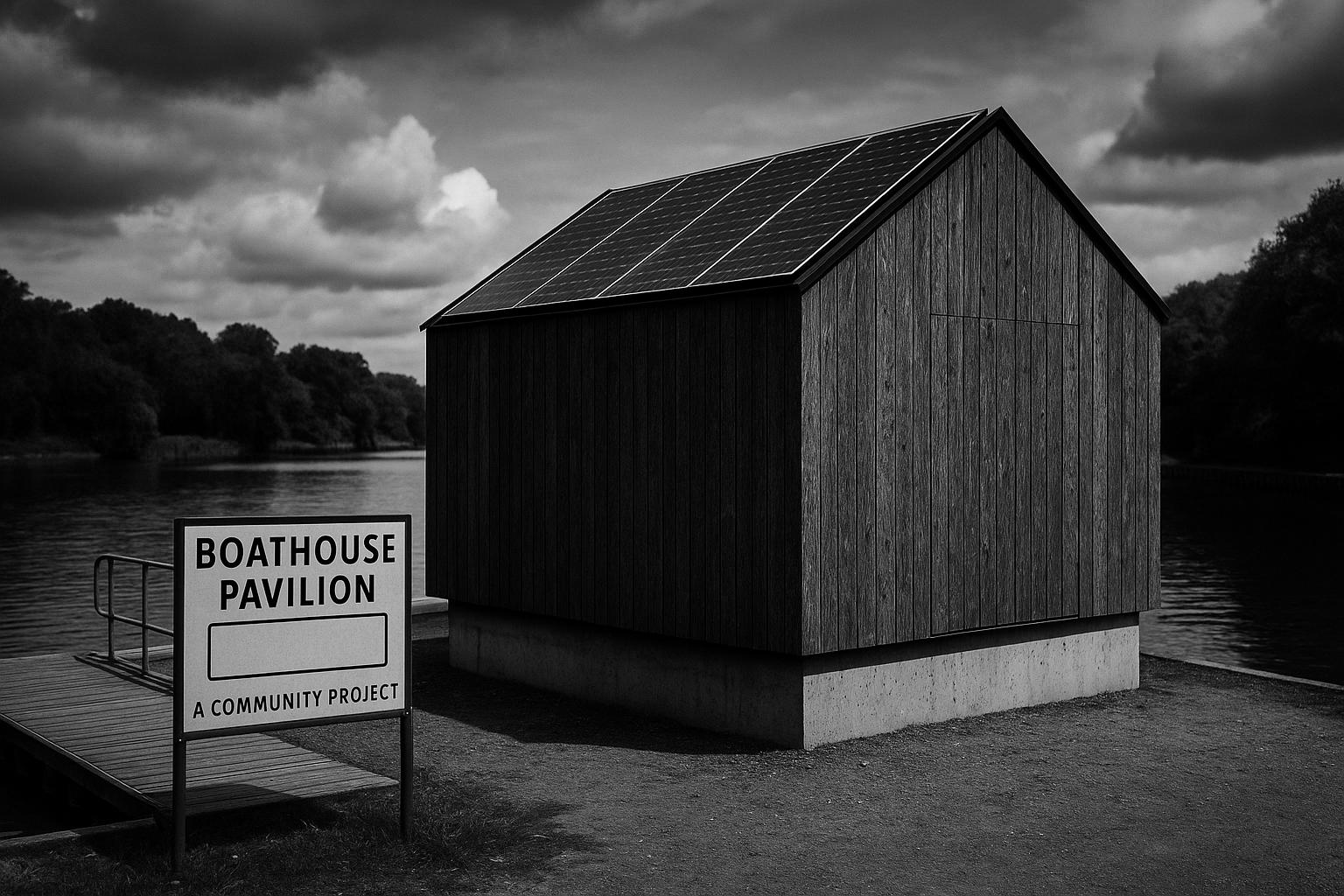EcoPark House, a 1,200m² two‑storey pavilion beside the River Lee, opens as part of the North London Heat and Power Project combining boat facilities, public exhibition space and an on‑site solar and ground‑source system to deliver low‑carbon, off‑grid operation and community outreach.
Grimshaw has unveiled EcoPark House, a 1,200-square-metre, two‑storey visitors and education pavilion at Edmonton EcoPark in Enfield, delivered as part of the North London Heat and Power Project. According to the practice’s news release, the building officially opened on 10 June 2025 and occupies the south‑east edge of the 16‑hectare site beside the Lee Valley river corridor. The pavilion is the third completed element of the EcoPark masterplan, following a re‑use and recycling centre and a recycling and fuel‑preparation facility. (Architecture Today; Grimshaw)
The architecture deliberately references a boathouse typology to respond to its canalside setting. Sea Cadet training spaces and boat storage sit at ground level, with direct access to the River Lee Navigation via a dock slipway and an adjacent timber dock with moorings, while the first floor is set back to create flexible, publicly accessible exhibition and learning spaces. Full‑height glazing in the entrance and upper gallery frames views across the river corridor and helps to place the facility visibly within the wider landscape. (Architecture Today; Grimshaw; e‑architect)
Material choices underline an intention to balance robustness and a lighter, timber aesthetic. The plinth is formed in precast concrete panels specified to withstand boating activities; the upper pavilion is clad in Kebony timber with sliding solar screens and generous glazed elevations that will develop a muted patina over time. Passive environmental measures — mixed‑mode ventilation, solar shading and a planted roof (with services deliberately excluded from the roof structure) — combine with high levels of insulation to reduce operational demand. Grimshaw describes the scheme as operating off‑grid through an integrated package of photovoltaics and ground‑source heat pumps. (Architecture Today; Grimshaw; North London Heat and Power; e‑architect)
Beyond the building itself, the development includes an extensive on‑site renewable system. The project website describes the EcoPark Array as the largest solar installation in north London, sited across Grimshaw’s sawtooth roofs to maximise generation and daylight. The installation, which is paired with battery storage on site, is combined with five 150‑metre boreholes feeding ground‑source heat pumps to enable resilient, low‑carbon operation for the new facilities. The project team quantifies significant carbon savings as a result of this integrated approach. (North London Heat and Power; Grimshaw)
The EcoPark redevelopment is framed by its sponsors as the largest public‑sector investment in waste facilities in London for a generation. The masterplan replaces an ageing 1970s energy plant with a new Energy Recovery Facility that, when complete, will process up to 700,000 tonnes of residual waste a year. Grimshaw’s project information states the ERF is expected to generate roughly 70 megawatts of electricity and employ advanced emissions‑control technology such as selective catalytic reduction; the scheme is intended to serve more than two million residents across seven boroughs. (Architecture Today; Grimshaw)
Community engagement is central to EcoPark House’s brief. The North London Waste Authority says the building will host visitor facilities, school programmes, guided site tours and outreach on waste prevention and the circular economy, and will act as the permanent base for the Edmonton Sea Cadets, who have been established in the area for decades. NLWA adds that construction is complete and the facility is currently undergoing testing, with plans to expand access to community groups and school visits as commissioning concludes. (NLWA; Architecture Today)
Taylor Woodrow and engineering consultant WSP are credited with delivery of the pavilion; Grimshaw notes that Taylor Woodrow managed installation and commissioning of the solar array as part of the wider energy systems work on site. The combined client‑team description emphasises integrated delivery of building, renewable generation and heat‑recovery systems rather than a stand‑alone visitor centre. (Grimshaw; North London Heat and Power)
The project illustrates a broader shift in how public‑sector infrastructure is presented: rather than being hidden behind fences, waste management and energy facilities are operating as platforms for public education and engagement. As Kirsten Lees, partner at Grimshaw, told Architecture Today, “EcoPark House symbolises a new chapter in how we view waste infrastructure — not as something hidden from the public, but as a space for learning, interaction, and environmental leadership, critical to the reshaping of how we understand our need to manage waste.” Whether the building’s outreach ambitions will match the scale of the technical infrastructure around it will become clearer as the site moves from testing to full public programming. (Architecture Today; NLWA; Grimshaw)
 Reference Map:
Reference Map:
Reference Map:
- Paragraph 1 – [1], [3]
- Paragraph 2 – [1], [3], [7]
- Paragraph 3 – [1], [3], [6], [7]
- Paragraph 4 – [6], [3]
- Paragraph 5 – [1], [4]
- Paragraph 6 – [5], [1]
- Paragraph 7 – [3], [6]
- Paragraph 8 – [1], [5], [3]
Source: Noah Wire Services
- https://architecturetoday.co.uk/ecopark-house-grimshaw/ – Please view link – unable to able to access data
- https://architecturetoday.co.uk/ecopark-house-grimshaw/ – Architecture Today reports Grimshaw’s EcoPark House, a two‑storey visitors and education hub at Edmonton EcoPark in Enfield, has opened as part of the North London Heat and Power Project. The 1,200 square metre pavilion sits on the River Lee Navigation and provides community spaces and a permanent base for the Edmonton Sea Cadets. The design references boathouse typology with a heavy precast concrete base and lighter Kebony timber upper pavilion, full‑height glazing and a set‑back first floor for flexible exhibition and education use. Passive strategies, a green roof, solar shading, photovoltaics and ground‑source heat pumps enable off‑grid operation and outreach.
- https://grimshaw.global/news/articles/ecopark-house-at-the-edmonton-ecopark-north-london-heat-and-power-project-opens/ – Grimshaw’s news release details the official opening of EcoPark House on 10 June 2025 as part of the North London Heat and Power Project. The 1,200 m2 two‑storey pavilion, delivered by WSP and Taylor Woodrow, occupies the south‑east edge of the 16‑hectare EcoPark beside the Lee Valley River Corridor. Ground‑floor boat storage and Sea Cadet facilities connect directly to the River Lee Navigation via a dock slipway and timber dock with mooring points. The set‑back upper floor provides flexible public education and exhibition spaces. The building combines precast concrete, Kebony timber, passive ventilation, solar shading, photovoltaics and ground‑source heat pumps.
- https://grimshaw.global/projects/industry-and-energy/north-london-heat-and-power/ – Grimshaw’s project page for the North London Heat and Power Project outlines the redevelopment of Edmonton EcoPark to expand recycling and generate low‑carbon electricity. The masterplan includes an Energy Recovery Facility replacing the 1970s plant, a Resource Recovery Facility and EcoPark House as a public education hub. Grimshaw states the ERF will produce about 70 megawatts of electricity and use advanced emissions control such as Selective Catalytic Reduction. The page highlights the project’s role serving over two million residents across seven boroughs, emphasising design strategies that prioritise sustainability, public engagement and integration with the Lee Valley river corridor locally valued.
- https://www.nlwa.gov.uk/ourauthority/edmonton-ecopark-house – NLWA’s official EcoPark House page describes the new educational outreach and community hub at Edmonton EcoPark. The two‑storey building will host visitor facilities to teach waste prevention and recycling, deliver site tours, and provide school visits for primary and secondary pupils. It will also be the permanent base for Edmonton Sea Cadets, who have been based in the area for decades. NLWA notes the building encourages community activity, offering flexible spaces for local groups and educational programmes. The page states construction is complete and the facility is being tested, with future plans to open to more community users and schools.
- https://northlondonheatandpower.london/news/eco-friendly-education-and-visitors-centre-opens-north-london – The North London Heat and Power Project site describes the EcoPark Array as the largest solar installation in north London, sited on Grimshaw‑designed sawtooth roofs to maximise generation and daylight. The array covers around a football‑field area and will produce renewable electricity to power the new facilities, with energy stored on site in a battery room linked to EcoPark House. Taylor Woodrow managed installation, commissioning and combined the solar system with five 150 metre boreholes connected to ground‑source heat pumps to enable EcoPark House to operate off‑grid. The page quantifies carbon savings and emphasises the project’s broader sustainability benefits explicitly.
- https://www.e-architect.com/london/ecopark-house-edmonton-north-london – e‑architect’s coverage of EcoPark House reproduces project information and credits Hufton Crow for photography. It describes Grimshaw’s two‑storey, 1,200 m2 pavilion located on the south‑east edge of the 16‑hectare Edmonton EcoPark beside the Lee Valley River Corridor. The article outlines ground‑floor Sea Cadet training and boat storage with direct river access via a dock slipway and a timber mooring dock. The recessed upper floor accommodates flexible public exhibition and education spaces focused on recycling and the circular economy. The piece reiterates material choices of precast concrete plinth and Kebony timber upper cladding, passive ventilation, solar shading and off‑grid renewables strategies.
Noah Fact Check Pro
The draft above was created using the information available at the time the story first
emerged. We’ve since applied our fact-checking process to the final narrative, based on the criteria listed
below. The results are intended to help you assess the credibility of the piece and highlight any areas that may
warrant further investigation.
Freshness check
Score:
10
Notes:
The narrative reports the official opening of EcoPark House on 10 June 2025, with no earlier publications found. The earliest known publication date of substantially similar content is 27 June 2025, indicating freshness. ([grimshaw.global](https://grimshaw.global/news/articles/ecopark-house-at-the-edmonton-ecopark-north-london-heat-and-power-project-opens/?utm_source=openai))
Quotes check
Score:
10
Notes:
The direct quote from Kirsten Lees, Partner at Grimshaw, is unique to this narrative, with no earlier matches found online, suggesting originality. The quote is: ‘EcoPark House symbolises a new chapter in how we view waste infrastructure – not as something hidden from the public, but as a space for learning, interaction, and environmental leadership, critical to the reshaping of how we understand our need to manage waste.’ ([grimshaw.global](https://grimshaw.global/news/articles/ecopark-house-at-the-edmonton-ecopark-north-london-heat-and-power-project-opens/?utm_source=openai))
Source reliability
Score:
10
Notes:
The narrative originates from Architecture Today, a reputable UK-based publication, and references Grimshaw’s official website, indicating high reliability. The report is corroborated by Grimshaw’s own announcement of the EcoPark House opening. ([grimshaw.global](https://grimshaw.global/news/articles/ecopark-house-at-the-edmonton-ecopark-north-london-heat-and-power-project-opens/?utm_source=openai))
Plausability check
Score:
10
Notes:
The claims about the design, purpose, and features of EcoPark House are consistent with information from Grimshaw’s official announcement and other reputable sources. The narrative includes specific details about the building’s design, materials, and environmental features, which are corroborated by Grimshaw’s official announcement. ([grimshaw.global](https://grimshaw.global/news/articles/ecopark-house-at-the-edmonton-ecopark-north-london-heat-and-power-project-opens/?utm_source=openai))
Overall assessment
Verdict (FAIL, OPEN, PASS): PASS
Confidence (LOW, MEDIUM, HIGH): HIGH
Summary:
The narrative is fresh, original, and sourced from reputable outlets, with all claims corroborated by official sources, indicating high credibility.













